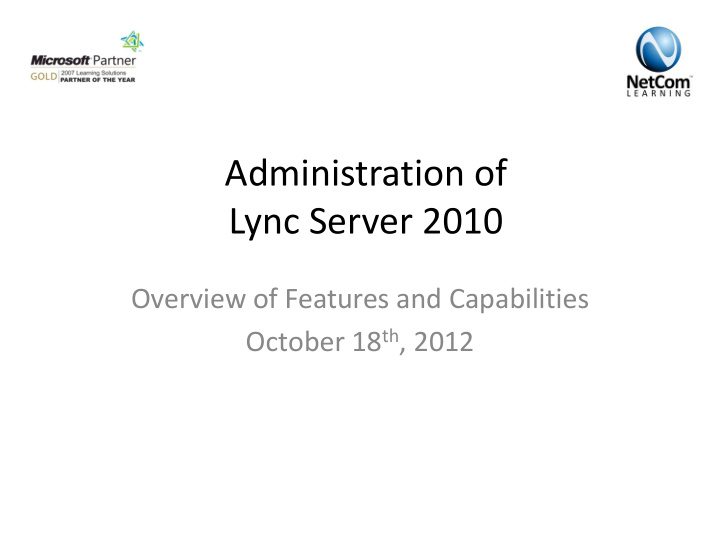



Administration of Lync Server 2010 Overview of Features and Capabilities October 18 th , 2012
• Helps you create an initial topology design • Collects component configuration information • Provides a preview of deployment • Exports XML file for Topology Builder
The Topology Publishing Process Planning Tool AD Domain Joined Lync Server SQL Back End System Local Setup AD Setup Installs Core Add/ Remove Install Retrieve If first pool is SE: Topology Topology SQL instance is SQL Builder Express Install Author desired Component Topology SQ SQ SQL L L Activate Publish Topology SQL Instance Central Management Certificates topology and configuration store Certificate Maintenance
Lync Control Panel
The Power Behind the Console • Lync Management Shell 2.0 cmdlets. • Runs on top of Powershell 2.0 Example cmdlet: New-CsUserReplicatorConfiguration
Changes in Lync configuration and data storage • Database Support Storage of Topology builder configuration data SQL Express at each Lync server, updated via subscription Independent of Active Directory NO Lync software needed on the SQL server
Central Management Store CMS provides centralized, schematized storage for: Configuration data User policy Topology for all servers and information information services • Configuration changes are replicated to all servers • Eliminates out-of-sync errors • Simplifies deployment and administration
Central Management Database The central management database: • Provides a robust, schematized storage of the data needed to define, set up, maintain, administer, describe, and operate a Lync Server 2010 deployment • Validates data to ensure configuration consistency • Replicates read-only copies of data to all servers in the topology, including Edge Servers
Troubleshooting and Support • Quality of Experience End user perspective • Call Detail Record Near real time monitoring
Lesson 2: Describing the Monitoring Service • Features and Components of the Monitoring Service • Quality of Experience and Call Detail Recording • SQL Server Reporting Services • Monitoring Policy Options
Features and Components of the Monitoring Service Features: • Richer reporting, including dashboard views • Comprehensive data for usage tracking and diagnosis • New management features • Optimized infrastructure Components: • Data collection agents • Monitoring server • Monitoring server databases • Message queuing • Systems Center Operations Manager (SCOM) • Monitoring Server Reports
Quality of Experience and Call Detail Recording Client (SIP) Caller Local or remote SQL database Monitoring Server with MSMQ MSMQ User view (SSRS)
Capabilities of Monitoring Server Identify and isolate problems Understand usage of Lync Server 2010 Use SCOM to receive alerts on server and network problems Perform troubleshooting Examine the media quality of real sessions Gather session usage statistics Generate standard reports
SQL Server Reporting Services
Monitoring Policy Options Cmdlet example: Get-CsQoEConfigurtation | fl Set-CsQoEConfiguration – Identity Global – EnableQoE $True – KeepQoEDataForDays 365
Troubleshooting with Lync Management Shell 31 distinct cmdlets to create • Test-CsAddressBookService synthetic transactions • Test-CsAddressBookWebQuery • Test-CsAVConference • Test-CsCertificateConfiguration Test-CsPhoneBootstrap • Test-CsClientAuth Test-CsPresence • Test-CsComputer Test-CsPstnOutboundCall Test-CsPstnPeerToPeerCall • Test-CsDialInConferencing Test-CsRegistration • Test-CsDialPlan Test-CsSetupPermission • Test-CsFederatedPartner Test-CsTopology • Test-CsGroupExpansion Test-CsTrunkConfiguration Test-CsVoiceNormalizationRule • Test-CsGroupIM Test-CsVoicePolicy • Test-CsIM Test-CsVoiceRoute • Test-CsKerberosAccountAssignment Test-CsVoiceTestConfiguration • Test-CsLisCivicAddress Test-CsVoiceUser • Test-CsLisConfiguration • Test-CsLocationPolicy • Test-CsOUPermission • Test-CsP2PAV
Overview of Lync Architecture • Data flow perspective • Server perspective
Lync Server 2010 Architecture Unifies Communications Endpoints - IW phones UC endpoints - Common Area Phones Windows Live Perimeter Messenger Network Third Party IMs Data Media SIP AD Remote Users Front End Server Back End SQL A/V Conferencing Archiving and Pool Server Server Monitoring Server Edge Server Federated Businesses Analog Survivable Branch Appliance Exchange Devices UM Media Gateway Direct SIP SIP Trunk On-Premises or PSTN Online
Lync Server 2010 Server Roles Front End Server Back End Server Monitoring Server Lync Server 2010 Server Roles Audio/Video Conferencing Server Archiving Server Edge Server Director Mediation Server
Maintenance • Backup • Monitoring • System Center Operations Manager
Backup Options for Lync Server 2010 Components Export-CsConfiguration Export-CsLisConfiguration DBImpExp Tool PowerShell Cmdlets SQL Server backup Certificate backup
System Center Operations Manager Design You can use Microsoft System Center Operations Manager 2007 or later for monitoring a variety of systems and platforms Synthetic Dashboard Report Actionable Alerts Transactions
Best Practices for Designing System Monitoring Employ system monitoring for business critical workloads Ensure monitoring solution is capable of measuring uptime and outages Deploy Lync Server 2010 monitoring role and Microsoft System Center Operations Manager 2007 or later Determine performance baselines Implement the monitoring strategy accurately
Quality of Experience Provides a user centric measurement of perceived audio quality at the individual endpoints Allows organizations to quickly respond to users or network segments experiencing poor audio quality Enables endpoints to submit performance and quality metrics at the end of each call through SIP communication Functions across any IP network Rates quality through Mean Opinion Score
Thank You! Back to Rinchen Stick around for Q&As www.netcomlearning.com
Recommend
More recommend